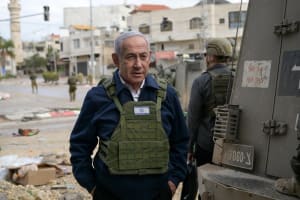INTERVIEW: Holocaust commemoration artist compares ‘Black Shabbat’ of Oct. 7 to 1941 pogrom in Iraq
Rachelly Roggel's parents fled the country following the terrible pogrom

When you meet the vivacious and fun-loving artist, you would never know what her parents had been through, or what her mother-in-law went through. Her beaming face does not betray how she delves so deeply into horrific stories, in order to provide unique educational experiences about the Holocaust. Her creative imprint on many other countries, as well as displays here in Israel, has even been the subject of a PhD.
“I do things that make me [gasp],” said Rachelly Roggel, the friendly, stylish little lady. “I have to be moved, otherwise I cannot. Someone can come and tell me, ‘Do a work’. I can’t do that. No, I have to be to be shocked. I have to be shocked.”
Roggel and her husband Amir’s beautiful Rehovot home is bursting with colorful pieces of intricate textiles, which have been insured, such is their worth in terms of the meaning they convey. Roggel's Holocaust commemoration artworks include: Auschwitz 1944 - "Hope dies last", for her mother-in-law; Bergen Belsen 1945, for her grandfather-in-law; and Lodz Ghetto, for the mother of her childhood friend.
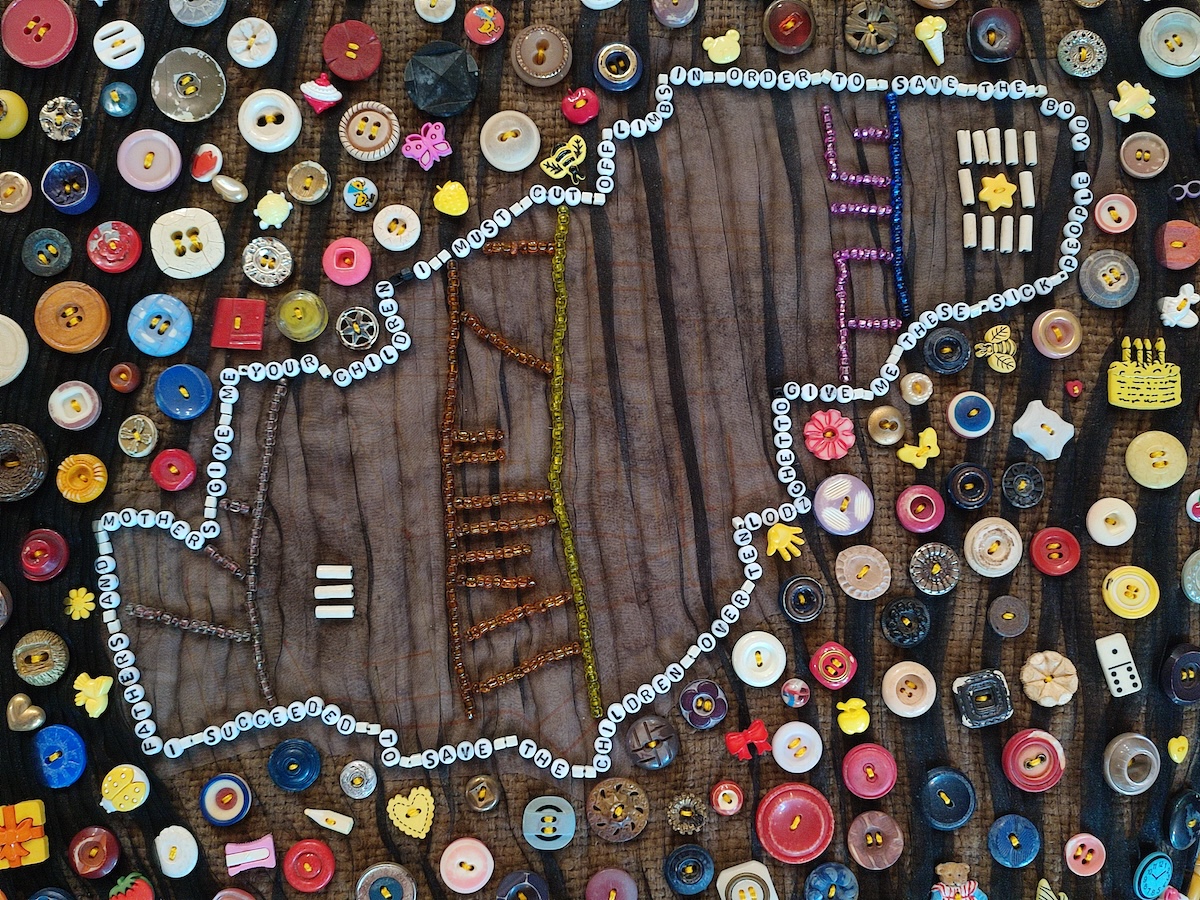
Roggel told to Bethlehem Voice radio journalist, Paul Calvert, what life was like for her parents:
“After 1941, my father always used to say, you can never believe the Muslims because they were our friends. And they murdered 175 people. They butchered them; they raped them. They did what Hamas did now on one day, [except] they did it for two days. It was in between regimes. And the British did not help. They let them murder and kill for two days before they intervened.”
Once Israel was independent, Roggel's parents decided to leave, but it meant leaving everything. “They couldn't take anything with them,” she explained. “On their passport was written, ‘going without coming back’. There is even a saying in Arabic… which means, ‘You're going and you will never be able to return’. So they left everything, the house and the money and the stores and came to Israel, because they wanted to be here.”
The journey involved a fair amount of danger, because the Jewish family had to go through Iran, having been smuggled over the border. Sometimes smugglers took the money and left the destitute refugees in the middle of nowhere. At one point, they were living in a cemetery during Winter.
Having arrived safely in the reborn State of Israel, the new immigrants initially lived in a tent, after having been well-off Iraqis. Roggel noted that it was so cold that year, that it even snowed in Tel Aviv. Later on, they moved into a wooden hut, and Rachelly remembers visiting her grandmother there. “It was considered to be, wow, luxury, really,” she said. “And to think that my father was a goldsmith, so they were very well-to-do people. And all of a sudden you have to go to the bathroom outside. It was rough.”
The fact that her parents never complained, is a point Roggel repeated: “They wanted to come here. And they never complained, even though they left a lot of good things there. I never heard my parents complain.”
Roggel turned to her artwork. First, the pieces in honor of her husband’s parents.
“My mother-in-law, she had her sweet 16th birthday at the gates of Auschwitz. It was on Shavu’ot [a Jewish holiday].” Roggel noted that the 1941 massacre in Iraq was also on Shavu’ot.
Continuing to describe Amir’s mother: “She was 16 years old, [from Hungary]. She was tall, she was red-headed, and she got a lot of beating because of that. She was with her sister, which was a good thing to be with your sister there. She was with her cousin, too. What can you say to a person who is 16 going through Auschwitz? It's a terrible thing. It's a terrible thing to go through Auschwitz.”
Although Rachelly’s mother-in-law was taken, by the British, to Cyprus, “with barbed wire…”, she eventually made it home to Israel and established a kibbutz. “She was like my own mother,” Roggel explained. “She was a very happy person, colorful, cheerful, a wonderful person, a wonderful person. She put [the Holocaust] aside, but it was always there.”
Roggel described how, when her parents-in-law went to Greece and were standing in line to see the Acropolis, the Auschwitz survivor couldn't stand it, being surrounded by people with backpacks. It reminded her of the morning roll call in the death camp. And being in Germany and hearing a dog barking, was one of the seemingly small things that took her straight back to her living teenage nightmare.
“She was not one to complain,” Roggel repeated three times. “And I'm very glad that she had two children because what she was going through in Auschwitz was the things that can stop you ever being pregnant. So. the fact that she had two children and she raised them was really lucky.”
To honor the memory of this amazing woman, Roggel took something very personal, her mother-in-law’s own dress. With it, she made an embroidered quilt about motherhood.
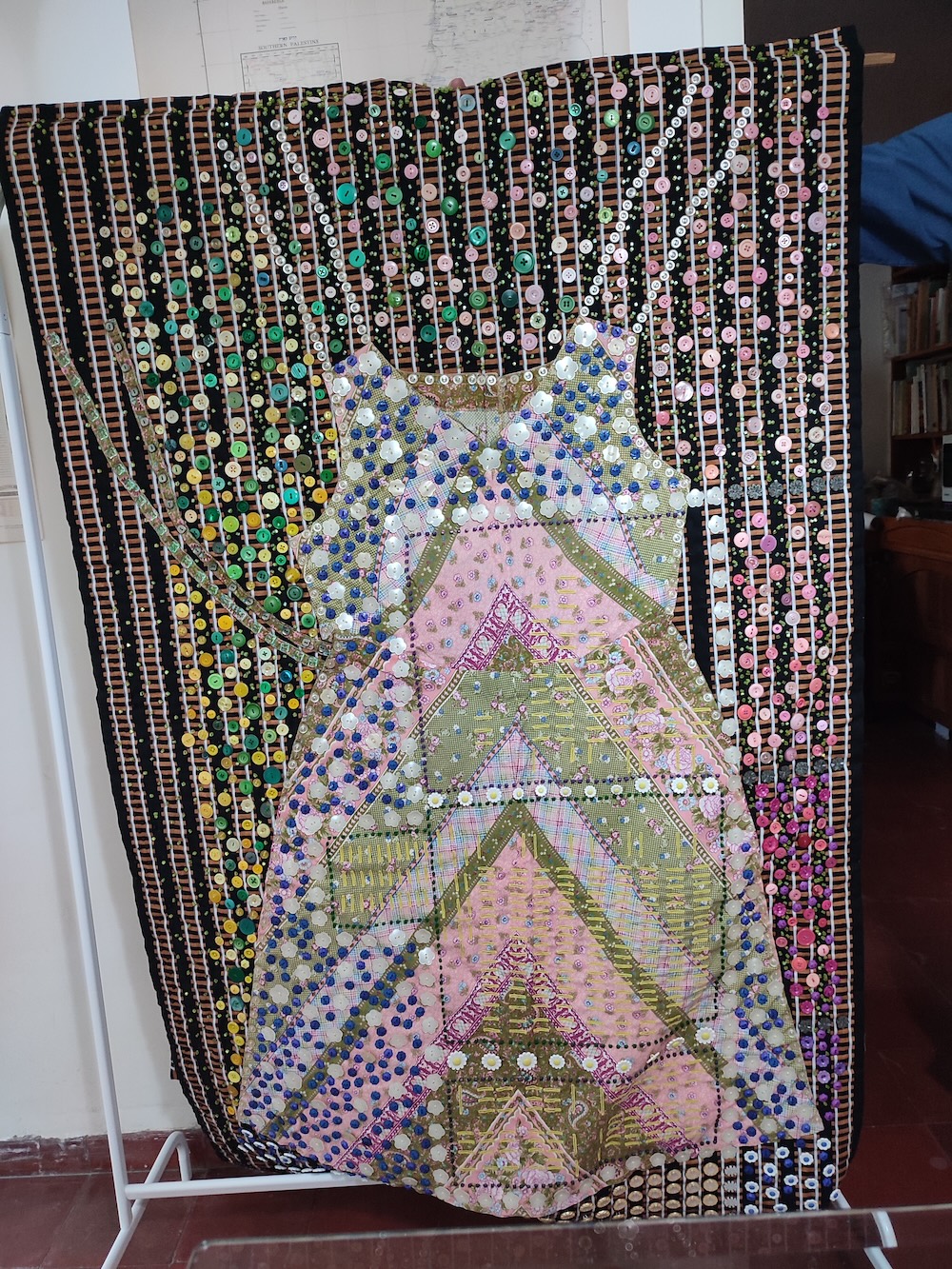
“It looks very colorful,” she said. “At the beginning, you see the train track and then you see the greenery, with plants, and then you see the flowers. And it is, as I said, it's cheerful, it's colorful, but when you look deeper, you see the imprint of Auschwitz…”
Roggel used buttons and buttonholes, showing all the camp barracks as buttonholes. “A buttonhole,” she explained, “even if you fix it, you can always see there was a buttonhole there, like a hurt… She fixed her life, but it was there all the time. It was [in the back of her mind]. When she was busy, she didn't really think about it, but when she was quiet and when the kids left the house, then it came back… but I always thank her for raising children like the way she raised them.”
Roggel also spoke about her father-in-law, who was in a labor camp during World War II. His father was sent to Bergen-Belsen and tragically died there of hunger. His mother, Amir’s grandmother, and her three other children were saved by a ‘Righteous Gentile’, Maria Rausenberger, from Austria.
One of these saved children, Amir’s uncle, was the one who later enabled the passage of Adolf Eichmann to Israel for the war crimes trial, in 1961. This saved child, as an adult, was the one who got close enough to take a photo of him and then forged his documents to get him out of Argentina. “So it was coming full circle with that lady, who really we can't say thank you to enough, that she saved them,” Roggel said.
Interestingly, being the wife of a Holocaust survivor’s child, is not what first motivated Roggel's artwork. She explained that she began her quest to find out more, since she lived in Givatayim, near Tel Aviv, as a child. At that time, many Holocaust survivors lived in the suburbs; Rachelly remembers that they had numbers tattooed on their arms.
“My best friend…” Roggel said. “Her mother was the one who gave testimony in the Eichmann trial. When I was in second grade, she said [her piece] in three minutes, the shortest in over 100 testimonies. And she was holding a photo. And Gideon Hausner [then-attorney general] asked her, ‘Why are you smiling in the photo? What are you smiling at?’ And she said, ‘I told my friends, (in Lodz Ghetto) ‘Let's pretend that tomorrow is going to be a happy day.’ A month later they were all exterminated.”
At the time, only in the second grade, Roggel didn't know too much. Then, when her own daughter reached 11th grade, she opened her history book, “and all of a sudden I see somebody who looks exactly like my friend!” Roggel realized that it was her, the mother, so she made another beautiful, poignant artwork about the Lodz Ghetto, Poland, which was the second largest in German-occupied Europe, after the Warsaw Ghetto.
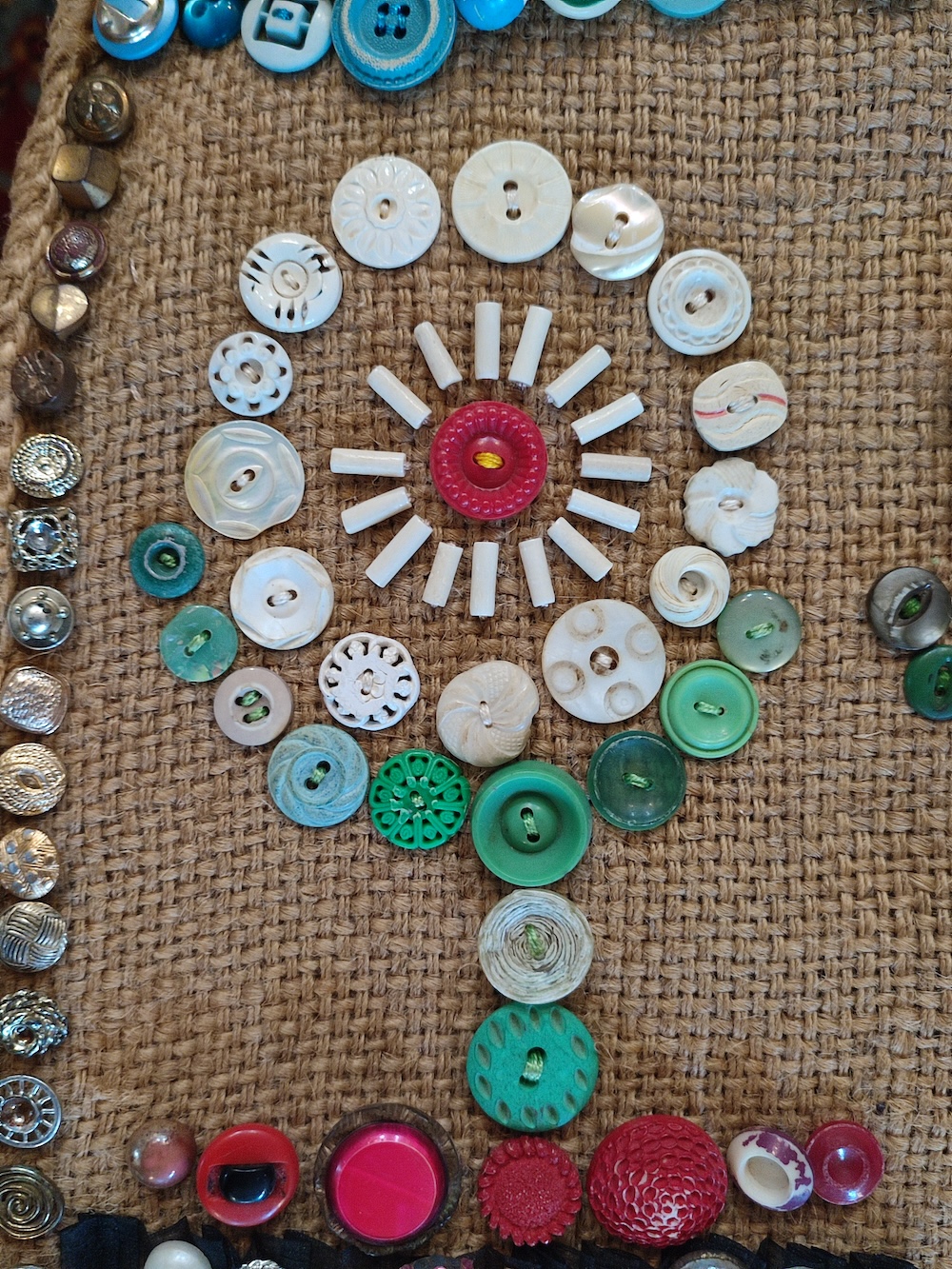
“Kids, ten years old, could [stay] alive because they could sew buttons,” Roggel explained. “Okay, buttons saved them. So here it is,” she said, pointing at the creation. “You see four flowers, right? And then, if you [follow the design], it's like the children, like a child drawing a child, you see the legs and the hands.”
Below the flower-shaped children, are many unique buttons. “Every button here is either old, broken or something childish,” she said. “Because Rumkowski [the Nazi-installed, Jewish Ghetto manager], in 1941 said, ‘Give me your children and old ones so I can save the rest.’ And nobody gave him the children…
“So this is the Lodz Ghetto, and those buttons are broken buttons. And those flowers, they’re not flowers. They're four burial pits where they put the kids in. And those beads are bone beads. And at the center of the flower are replica of the buttons that are found from Lodz, and are in the museum in Yad Vashem. So it looks naive and it looks cute and it looks childish. But that's Lodz.”
Calvert pointed out that it seems a great way of teaching the Holocaust to younger people, in particular. Roggel agreed: “Yes.. sometimes people don't want to hear about atrocities and they don't want to see atrocities. And, you know, ‘Don't talk to me about it.’ But here, it's all nice. It's colorful. Oh, I remember there is an ice cream button here. Oh, there is a.. you see a house here. There is a spoon. There is something else. They are looking, looking, looking at it. And I can tell them that those kids, in the end, were driven in buses with a muffler inside, so they were suffocated on the way. They opened the bus and they were gassed.”
About her mother-in-law’s dress, Roggel said that people enjoy the colors and details, but when she explains the deeper meaning, they begin to cry. Something so beautiful doesn’t look like the Holocaust, but in a time when ‘Never Again’ needs reinforcing more than ever, this artwork is a powerful tool.
Calvert asked Roggel how she felt about the Oct. 7 invasion and massacres, considering her work focuses so much on the Holocaust.
“Even worse,” she replied. “I mean, it's like we could never believe this can happen. Never believe this can happen. Never. I mean, the Holocaust was.. we were Jews. We didn't have a state. We didn't have an army. We didn't have anything to protect us. This has happened here. I mean… this has happened by people who worked in Israel, who got their salary from Israel, who got their water from Israel. And they are paying us with this? I mean, they are paying us with killing us, butchering us? It's total.. You cannot even accept it. It's just something that.. it's awful. It's the worst. It's worse than ISIS. It's worse than ISIS.”
Rachelly has already been busy creating another heartfelt piece to try to reflect what happened, unbelievably in 2023.
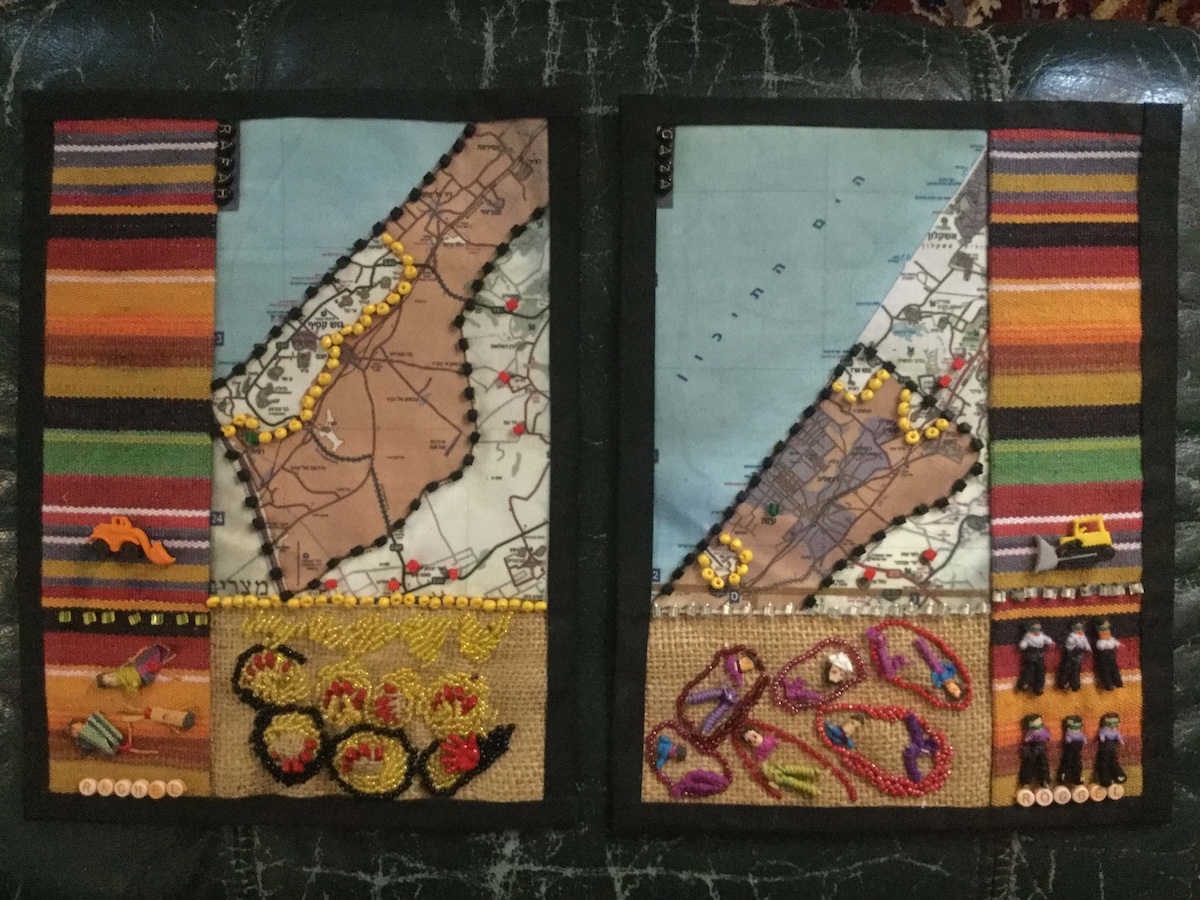
“I took the Gaza Strip,” she explained, "made it into two parts. And I used ‘worry dolls.’" The tiny cloth dolls are a feature of Roggel's Holocaust quilts. Originating from indigenous Central American culture, worry dolls are placed under the pillow at night, the idea being the dolls worry instead of the person asleep. “And in the morning you can decide if you want to keep worrying about something,” Roggel said.
“And I took all these worry dolls and they are cut and mutilated, like Hamas did it. And there is here the tractor that pushed through the wall…”
“Here, with Hamas, you've got green across their faces,” Calvert said, speaking of the bright green headbands worn by the terrorists. Roggel described the most harrowing part of the story she was having to process, trying to convey the horror.
“And on the other side, I must admit, there are the people who are burned alive. The baby who was in the oven burned alive. And there were, if you can see that they are undressed, their dresses are pushed and they are being raped. And that was extremely, extremely, extremely hard to do. I was like, thinking of each of them that was raped, the one who was on the truck and you could see her legs were totally not in place. And the people who are naked and all those photos that [the terrorists] sent on Telegram.
“When I was doing it, I was thinking about it. A poor, poor, poor, poor woman who had gone to lived hell, lived hell, by being raped by tens of people and being shot after that and being burned alive, burned alive - just awful. It’s just something that you can never forget.”
When asked about her prayer for the future of Israel, Roggel sighed heavily. “First of all, we are all damaged now - mentally. We're all damaged now. It's traumatic. Everybody knows somebody who knows somebody.”
And then, speaking, like many Israelis, as part of a family that has overcome so much hardship, she admitted: “But we’ll have to. We’ll have to come alive. We have no other choice. It happened in our state - you know - we have no other choice. This is a place where we're going to be. As the daughter of Iraqis for whom there was no going back, she repeats, “We have no other choice. This is our place.”
Click below to listen to the full interview with Calvert.

The All Israel News Staff is a team of journalists in Israel.











